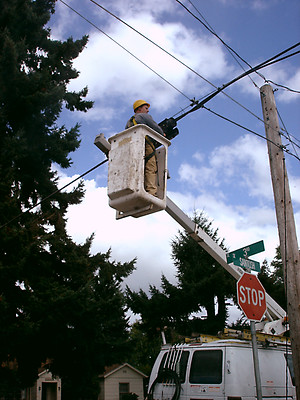Earlier this week, I ran across an article in the Alpena News about a new workforce development program that Alpena Community College is offering. The eight-week program teaches participants how to work around power lines, removing vegetation and trees that could interfere with power delivery. According to the article, ” Any plant life that interferes with a power line can be dangerous, so they need special training to handle these removals.”
The article went on to discuss utility arborists, what they do, what’s involved with the program, etc. in addition to the training, a utility arborist also needs a CDL and pesticide license. According to ACC, the program will be offered again in the fall as a 16-week course.
All well and good. Until you check the pay for this dangerous job that requires special training and not one but two discrete licenses. Salaries for utility arborists in the United States range from $21,700 to $55,700 per year. Restated, that’s between $10.43 and $26.77 per hour. The middle 60% of all utility arborists make on average $16.11 per hour.
For the dangerous job that requires two different licenses and special training, so you don’t get killed.
There is no doubt in my mind that these jobs represent a useful community service. It is useful to have people who know how to remove overgrowth and other vegetation that has made physical contact with power lines. That value probably exceeds $11 or $16 per hour. Or even $27 per hour. Given that the alternatives include death and injury, damage to the power system, power outages, fires and other hazards, the work is worth a lot.
Workforce development is a euphemism for corporate welfare
There are eight electric power companies that the Michigan Public Service Commission regulates. Alpena Power Company, which presumably benefits from ACC’s new program, reported more than $2.2 million in net profits in 2021. APC is one of the smallest power generation companies in the state. Consumer’s Power, which could conceivably benefit from the program, reported total net assets of more than $25B in 2021, which included (in part) a new rate increase for 2021 that generated $90M for the company. DTE reported 2021 net earnings of $907M.
Power companies are not poor. They operate in a highly regulated industry that doles out regional monopolies. As a result, market forces do not operate here. Regulatory agencies must impose rate limits on these companies to prevent them from abusing their state-sponsored monopolies.
Unfortunately, community colleges inexplicably gravitate to workforce development programs that pay chronically low wages for dangerous, demanding work, often to serve employers who measure their profits in millions of dollars. This is not workforce development as much as it is corporate welfare. Community colleges need to get out of the business of catering to companies that can provide their own training programs for low wage work.
Photo Credit: Curtis Gregory Perry , via Flickr












